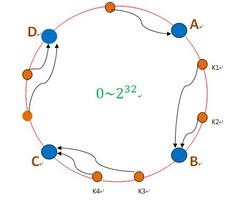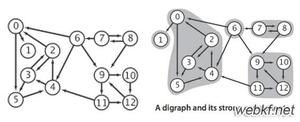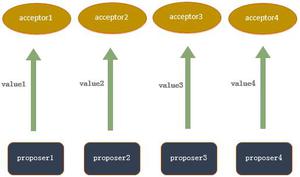A_Star算法

摘录A*算法的erlang实现
- 原作者出自:https://stevegilham.blogspot.com/2008/10/first-refactoring-of-star-in-erlang.html
-module(a_star).-export([main/0]).
astar(Start,Goal) ->
Closedset = sets:new(), % The set of nodes already evaluated.
Openset = sets:add_element(Start,sets:new()), %The set of tentative nodes to be evaluated
Fscore = dict:append(Start, h_score(Start), dict:new()),
Gscore = dict:append(Start, 0, dict:new()), % Distance from start along optimal path.
CameFrom = dict:append(Start, none, dict:new()),
astar_step(Goal, Closedset, Openset, Fscore, Gscore, CameFrom).
astar_step(Goal, Closedset, Openset, Fscore, Gscore, CameFrom) ->
case sets:size(Openset) of
0 ->
failure;
_ ->
case best_step(sets:to_list(Openset), Fscore, none, infinity) of
Goal ->
reconstruct_path(CameFrom, Goal);
X ->
NextOpen = sets:del_element(X, Openset),
NextClosed = sets:add_element(X, Closedset),
Neighbours = neighbour_nodes(X),
{NewOpen, NewF, NewG, NewFrom} = scan(X, Neighbours, NextOpen, NextClosed, Fscore, Gscore, CameFrom),
astar_step(Goal, NextClosed, NewOpen, NewF, NewG, NewFrom)
end
end.
scan(_X, [], Open, _Closed, F, G, From) ->
{Open, F, G, From};
scan(X, [Y|N], Open, Closed, F, G, From) ->
case sets:is_element(Y, Closed) of
true ->
scan(X, N, Open, Closed, F, G, From);
false ->
[G0] = dict:fetch(X, G),
TrialG = G0 + dist_between(X,Y),
case sets:is_element(Y, Open) of
true ->
[OldG] = dict:fetch(Y, G),
case TrialG < OldG of
true ->
{NewF, NewG, NewFrom} = update(X, Y, F, G, From, TrialG),
scan(X, N, Open, Closed, NewF, NewG, NewFrom);
false ->
scan(X, N, Open, Closed, F, G, From)
end;
false ->
NewOpen = sets:add_element(Y, Open),
{NewF, NewG, NewFrom} = update(X, Y, F, G, From, TrialG),
scan(X, N, NewOpen, Closed, NewF, NewG, NewFrom)
end
end.
update(X, Y, OldF, OldG, OldFrom, GValue) ->
KeyF = dict:is_key(Y, OldF),
KeyG = dict:is_key(Y, OldG),
KeyFrom = dict:is_key(Y, OldFrom),
case {KeyF, KeyG, KeyFrom} of
{true, _, _} ->
update(X, Y, dict:erase(Y, OldF), OldG, OldFrom, GValue);
{_, true, _} ->
update(X, Y, OldF, dict:erase(Y, OldG), OldFrom, GValue);
{_, _, true} ->
update(X, Y, OldF, OldG, dict:erase(Y, OldFrom), GValue);
_ ->
NewFrom = dict:append(Y, X, OldFrom),
NewG = dict:append(Y, GValue, OldG),
NewF = dict:append(Y, GValue + h_score(Y), OldF), % Estimated total distance from start to goal through y.
{NewF, NewG, NewFrom}
end.
reconstruct_path(CameFrom, Node) ->
case dict:fetch(Node, CameFrom) of
[none] ->
[Node];
[Value] ->
[Node | reconstruct_path(CameFrom, Value)]
end.
best_step([H|Open], Score, none, _) ->
[V] = dict:fetch(H, Score),
best_step(Open, Score, H, V);
best_step([], _Score, Best, _BestValue) ->
Best;
best_step([H|Open], Score, Best, BestValue) ->
[Value] = dict:fetch(H, Score),
case Value < BestValue of
true ->
best_step(Open, Score, H, Value);
false ->
best_step(Open, Score, Best, BestValue)
end.
%% specialize for the torch-carrier problem
%% bits 0-4 represent torch, 1m, 2m, 5m, 10m
%% set bit = on the near side
%% Every possible crossing of one or two
swaps() ->
[3,5,9,17, 7, 11,13, 19,21,25].
crossing_time(Swap) ->
if
Swap band 16 > 0 ->
10;
Swap band 8 > 0 ->
5;
Swap band 4 > 0 ->
2;
true ->
1
end.
%% presentation form
display(Swap) ->
if
Swap band 16 > 0 ->
compound(Swap, 16);
Swap band 8 > 0 ->
compound(Swap, 8);
Swap band 4 > 0 ->
compound(Swap, 4);
Swap band 2 > 0 ->
compound(Swap, 2);
true ->
""
end.
compound(Swap, Bit) ->
string:concat( erlang:integer_to_list(crossing_time(Swap)),
decorate(display(Swap bxor Bit))).
decorate(Value) ->
case string:len(Value) of
0 ->
Value;
_ ->
string:concat("+", Value)
end.
neighbour_nodes(X) ->
Result = [],
compatible(X, equivalent_point(X), Result, swaps()).
equivalent_point(X) ->
case X band 1 of
1 ->
X;
0 ->
31 bxor X
end.
compatible(_X, _Y, Outlist, []) ->
Outlist;
compatible(X, Y, Outlist, [Swap|Inlist]) ->
case (Y band Swap) of
Swap ->
New = X bxor Swap,
compatible(X, Y, [New|Outlist], Inlist);
_ ->
compatible(X, Y, Outlist, Inlist)
end.
dist_between(X,Y) ->
Swap = X bxor Y,
crossing_time(Swap).
h_score(Node) ->
crossing_time(Node).
main() ->
[H|Trace] = lists:reverse(astar(31, 0)),
Time = print_result(Trace, H, 0),
io:format("Time taken = ~B minutes~n", [Time]) .
print_result([], _Prev, Time) ->
Time;
print_result([H|Trace], Prev, Time) ->
Swap = H bxor Prev,
print_swap(Swap, H band 1),
Interval = Time + crossing_time(Swap),
print_result(Trace, H, Interval).
print_swap(Swap, Side) ->
case Side of
0 ->
io:format( " ~s -->;~n", [display(Swap)]);
1 ->
io:format( "<-- ~s~n", [display(Swap)])
end.
以上是 A_Star算法 的全部内容, 来源链接: utcz.com/z/514786.html









